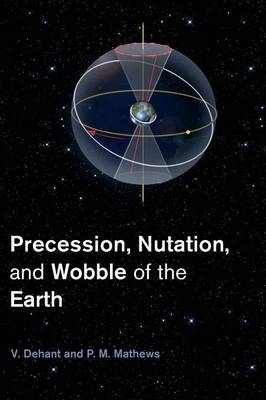
Precession, Nutation and Wobble of the Earth
Cambridge University Press (Verlag)
978-1-107-09254-9 (ISBN)
Covering both astronomical and geophysical perspectives, this book describes changes in the Earth's orientation, specifically precession and nutation, and how they are observed and computed in terms of tidal forcing and models of the Earth's interior. Following an introduction to key concepts and elementary geodetic theory, the book describes how precise measurements of the Earth's orientation are made using observations of extra-galactic radio-sources by Very Long Baseline Interferometry techniques. It demonstrates how models are used to accurately pinpoint the location and orientation of the Earth with reference to the stars, and how to determine variations in its rotation speed. A theoretical framework is also presented that describes the role played by the structure and properties of the Earth's deep interior. Incorporating suggestions for future developments in nutation theory for the next generation models, this book is ideal for advanced-level students and researchers in solid Earth geophysics, planetary science and astronomy.
V. Dehant is Senior Research Scientist at the Royal Observatory of Belgium, responsible for the operational direction 'Reference Systems and Planetology', and is a part-time professor at the Université Catholique de Louvain. Her research is focused on the interior, rotation, and habitability of the terrestrial objects of our Solar System, mostly in relation to the evolution of their interiors and atmospheres. Professor Dehant is also Principal Investigator and Co-Investigator of several instruments in European Space Agency (ESA) and NASA missions, and has received several awards including the Descartes Prize of the European Union. She is involved in the ESA Space Science Advisory Committee (SSAC) and is a member of the Royal Academy of Belgium (Science Class). She is the author of more than 400 publications. P. M. Mathews served as Senior Professor of Theoretical Physics at the University of Madras in India, and is now retired. His main research interests are in the Earth's nutation and precession, and other concomitant phenomena, as well as the properties of, and processes in, the Earth's deep interior. Professor Mathews is the lead originator of the Mathews-Herring-Buffett (MHB) theory of nutation adopted by the International Astronomical Union and International Union of Geodesy and Geophysics. In recognition of his work on the MHB model of nutation, he was elevated to the Fellowship of the American Geophysical Union (2004). He was elected as a Fellow of the Indian Academy of Sciences in 1975 and of the Indian National Science Academy in 1983. He has published 120 papers in reputable journals.
Preface; List of acronyms; 1. Introduction, fundamental definitions and motivation; 2. Concepts and elementary theory; 3. Reference systems and frames; 4. Observational techniques: ephemerides; 5. Rigid Earth precession and nutation; 6. Deformable Earth and Love numbers; 7. Nutations of a non-rigid Earth; 8. Anelasticity; 9. Ocean and atmospheric corrections; 10. Refinements of nonrigid nutation; 11. Comparison observation-theory; 12. Conventions; 13. Mars nutations; Appendix A. Rotation representation; Appendix B. Clairaut theory; Appendix C. Definitions of equinoxes; Bibliography; Index.
| Zusatzinfo | 11 Tables, black and white; 41 Line drawings, black and white |
|---|---|
| Verlagsort | Cambridge |
| Sprache | englisch |
| Maße | 162 x 235 mm |
| Gewicht | 550 g |
| Themenwelt | Naturwissenschaften ► Biologie ► Ökologie / Naturschutz |
| Naturwissenschaften ► Geowissenschaften ► Geologie | |
| Naturwissenschaften ► Geowissenschaften ► Geophysik | |
| Naturwissenschaften ► Physik / Astronomie ► Astronomie / Astrophysik | |
| ISBN-10 | 1-107-09254-X / 110709254X |
| ISBN-13 | 978-1-107-09254-9 / 9781107092549 |
| Zustand | Neuware |
| Haben Sie eine Frage zum Produkt? |
aus dem Bereich


